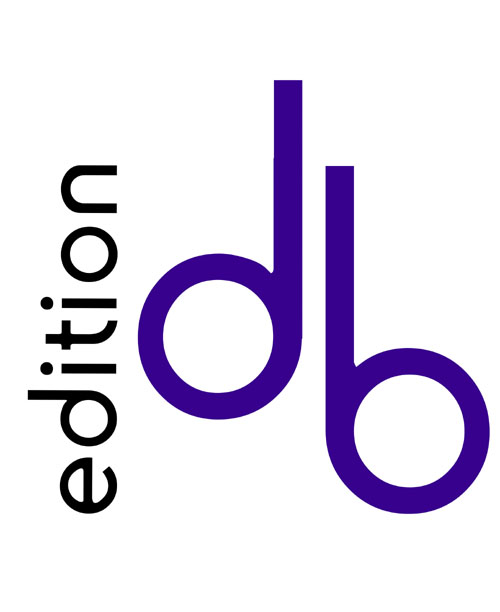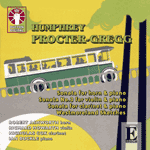
- 7 clarence grove
- horsforth
- leeds, LS18 4LA
- UK
- tel: 0113 258 1300
- order online
- order by fax
- www.editiondb.com
- 0113 258 2556
- info@editiondb.com
CD Review:
Sonata for horn and piano by Humphrey Procter-Gregg
- Humphrey Procter-Gregg
- Sonata No.3 in F for violin and piano
- Sonata for clarinet and piano (c. 1943)
- Sonata in A for horn and piano (1975)
- Westmoreland Sketches for piano (1968):
- Shower in Spring (no.23)
- Summer Dreams (no.24)
- Autumn Reflections (no.25)
- Winter Elegy (no.26)
- ________________________________________________________________
- Richard Howarth (violin)
- Nicholas Cox (clarinet)
- Robert Ashworth (horn)
- Ian Buckle (piano)
- Dutton Epoch CD LX 7165
When asked to review any CD for this magazine which contains one work for horn, one criterion must be how worthwhile the rest of the music on the CD is. Would I buy it and listen to it?
The music on this CD is all by Hubert Procter-Gregg who was born at Kirby Lonsdale in 1895. He was a student at Cambridge and then went to the Royal College of Music where he studied composition with Stanford. He subsequently won a scholarship to La Scala Milan where his love of opera grew so that in addition to composition he became a passionate advocate of opera in England. This eventually led him to become Artistic Director of the Carl Rosa Opera Company after the Second World War whence he became a colleague and friend of Beecham (and subsequently his biographer). Procter-Gregg then became the first Professor of Music at Manchester University.
What of his music which spans more than six decades? It very much in the English tradition of the early 20th century and it changed little with time. All the music on this CD was actually written after 1940. His style is lyrical and has a very strong affinity for each of the instruments for which he writes. The violin sonata is quite dark whereas the clarinet sonata is bright and fluid. Both are given excellent performances by Richard Howarth and Nicholas Cox accompanied by Ian Buckle. Ian also plays some nostalgic late piano pieces which recall Procter-Gregg's beloved Lake District (he lived in Windermere towards the end of his life).
The horn sonata was written in 1975 for Bob Ashworth who gave the first performance at a concert to celebrate Procter-Gregg's 80th birthday. In his programme note Procter-Gregg wrote: "The horn with its lovely sound and huge compass nevertheless has intrinsic difficulties which in chamber music sets problems both pneumatic and hydraulic"! In the Horn Sonata he certainly makes use of the compass of the instrument, particularly the low register.
I am not sure about the hydraulic problems but Bob certainly makes light of the pneumatic ones. Somebody once said to me "when you hear Bob play you hear Sydney Coulston". This was very much brought to mind when I heard this disc. I am sure that Sydney, who was Bob's mentor, would have been very pleased with this performance. In answer to my initial query, I can say that the works by Procter-Gregg on this CD are both varied and interesting and that I have listened to it a number of times with great pleasure.
Paul Sawbridge, The Horn Player, BHS
_________________________________________________________________________________________________________________________________
Humphrey Procter-Gregg. Robert Ashworth, hornist with pianist Ian Buckle. Epoch/Dutton Laboratories catalogue number CDLX-7165. Timing: 22:36 (for the one work in question). Recorded at The King’s School, Macclesfield UK, March and April 2005.
Contents: music of Humphrey Procter-Gregg including his Sonata in A major (1975) (horn and piano), and works for piano: clarinet and piano: violin and piano.
While I am not keen about reviewing a disc with only one work for horn on, this 22-minute sonata by Humphrey Procter-Gregg (1895-1980) is well worth adding to your collection. It is ably performedhere by Robert Ashworth for whom the work was written and who performed it at the composer’s birthday concert in 1975.
It opens with a wonderful cantabile melody in the horn’s middle range, displaying its Romantic timbre and wide dynamic compass. The first movement is cheerful and lyrical, and the second is nostalgic. The finale opens with a jocular fugue, tightly interwoven between horn and piano, a solemn middle section, and a coda that takes the horn to high a” for a brilliant conclusion.
The music is tonal and romantic in style, with harmonies that pre-date Mahler and Strauss and no unexpected modulations associated with Post-Romanticism. There are no stratospheric reaches for the hornist, rather it is predominantly written in the middle range of the instrument. The piano part is most challenging, similar to the level of Beethoven’s Horn Sonata, Op.17.
This sonata was composed in the nineteenth-century Brahmsian concept of the horn and deserves to be heard regularly.
John Dressler, The Horn Call, IHS, Vol XXXVII No.1, October 2006
